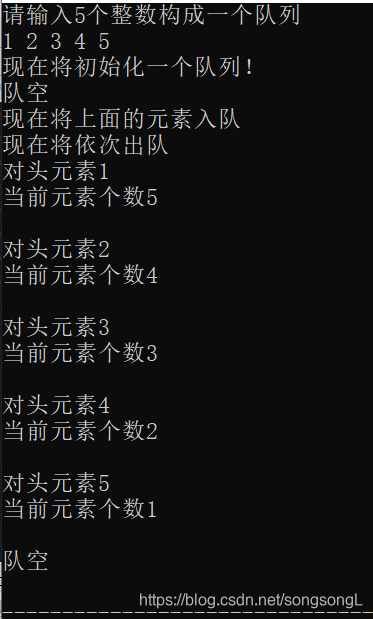@[TOC]
队列
- 逻辑结构:线性表
- 存储结构:顺序存储\链式存储
- 基本运算:
- 初始化
- 判断队空
- 判断队满
- 入队
- 出队
- 访问队头
注意:队列也是线性表,其特殊性在于有特殊的运算规则。即:队结构只能在一端进行插入,该操作端称为队尾,另一端删除元素,该操作端称为队头。按照“先进先出”(First In First Out,FIFO)原则处理数据节点。
1.循环队列
之所以用循环对列,就是了为了提高利用率。要不然每删除一个元素,对头就空了一个还用不了了。
实现循环,就用“模”运算:
队空的条件:Q.front == Q.rear
堆满条件:(Q.rear+1)%Max == Q.front
队列的定义
1
2
3
4
5
6
7
| typedef int ElemType;
typedef struct{
ElemType *base;
int front;
int rear; //队头、尾
}SqQueue;
|
初始化
1
2
3
4
| void SqQueueInit(SqQueue &Q){ //初始化队列
Q.base=new ElemType[MAX];
Q.front=Q.rear=0;
}
|
判断队空
1
2
3
4
5
6
| bool SqQueueEmpty(SqQueue Q){ //判断队列空
if(Q.front==Q.rear){
return true;
}
else return false;
}
|
判断队满
1
2
3
4
5
6
| bool SqQueueFull(SqQueue Q){ //判断队列满
if((Q.rear+1)%MAX==Q.front){
return true;
}
else return false;
}
|
回到目录
入队
1
2
3
4
5
6
7
8
9
| SqQueue SqQueueIn(SqQueue Q,ElemType x){ //入队
if(SqQueueFull(Q)){
cout<<"队满了"<<endl;
return Q;
}
Q.base[Q.rear]=x;
Q.rear=(Q.rear+1)%MAX;
return Q;
}
|
出队
1
2
3
4
5
6
7
8
9
| SqQueue SqQueueOut(SqQueue Q,ElemType *x){//出队
if(SqQueueEmpty(Q)){
cout<<"队空"<<endl;
return Q;
}
*x=Q.base[Q.front];
Q.front=(Q.front+1)%MAX;
return Q;
}
|
访问队头
1
2
3
| ElemType GetSqQueueTop(SqQueue Q){ //访问队头元素
return (Q.base[Q.front]);
}
|
计算队列长度
1
2
3
| int GetQueueLength(SqQueue Q){ //元素个数
return (Q.rear-Q.front+MAX)%MAX;
}
|
回到目录
总的代码:
1
2
3
4
5
6
7
8
9
10
11
12
13
14
15
16
17
18
19
20
21
22
23
24
25
26
27
28
29
30
31
32
33
34
35
36
37
38
39
40
41
42
43
44
45
46
47
48
49
50
51
52
53
54
55
56
57
58
59
60
61
62
63
64
65
66
67
68
69
70
71
72
73
74
75
76
77
78
79
80
81
82
83
84
85
86
87
88
89
90
91
92
| #include<iostream>
#define MAX 100 //定义队列的最大值
using namespace std;
typedef int ElemType;
typedef struct{
ElemType *base;
int front;
int rear; //队头、尾
}SqQueue;
void SqQueueInit(SqQueue &Q){ //初始化队列
Q.base=new ElemType[MAX];
if(!Q.base)
exit(1);
Q.front=Q.rear=0;
}
bool SqQueueEmpty(SqQueue Q){ //判断队列空
if(Q.front==Q.rear){
return true;
}
else return false;
}
bool SqQueueFull(SqQueue Q){ //判断队列满
if((Q.rear+1)%MAX==Q.front){
return true;
}
else return false;
}
SqQueue SqQueueIn(SqQueue Q,ElemType x){ //入队
if(SqQueueFull(Q)){
cout<<"队满了"<<endl;
return Q;
}
Q.base[Q.rear]=x;
Q.rear=(Q.rear+1)%MAX;
return Q;
}
ElemType GetSqQueueTop(SqQueue Q){ //获取队头元素
return (Q.base[Q.front]);
}
int GetQueueLength(SqQueue Q){ //元素个数
return (Q.rear-Q.front+MAX)%MAX;
}
SqQueue SqQueueOut(SqQueue Q,ElemType *x){ //出队
if(SqQueueEmpty(Q)){
cout<<"队空"<<endl;
return Q;
}
*x=Q.base[Q.front];
Q.front=(Q.front+1)%MAX;
return Q;
}
int main(){
//测试
int a[5];
cout<<"请输入5个整数构成一个队列" <<endl;
for(int i=0;i<5;i++){
cin>>a[i];
}
SqQueue s;
SqQueueInit(s);
cout<<"现在将初始化一个队列!"<<endl;
if(SqQueueEmpty(s)){
cout<<"队空"<<endl;
}
else cout<<"队非空"<<endl;
cout<<"现在将上面的元素入队"<<endl;
for(int i=0;i<5;i++){
s=SqQueueIn(s,a[i]);
}
cout<<"现在将依次出队"<<endl;
for(int i=0;i<5;i++){
cout<<"对头元素"<<GetSqQueueTop(s)<<endl;
cout<<"当前元素个数"<<GetQueueLength(s)<<endl<<endl;
s=SqQueueOut(s,&s.front);
}
if(SqQueueEmpty(s)){
cout<<"队空"<<endl;
}
else cout<<"队非空"<<endl;
return 0;
}
|
运行结果:

回到目录
2.链队
链队的定义
1
2
3
4
5
6
7
8
9
10
11
12
13
14
15
16
| typedef int DATATYPE;
typedef struct QNode //定义节点
{
DATATYPE data;
struct QNode * next;
}QNode,*Queue;
typedef struct //定义一个链队
{
Queue front; //队头指针
Queue rear; //队尾指针
int count; //计数器 记录链队的元素个数
}LinkQueue;
|
初始化
1
2
3
4
5
6
7
8
| void init(LinkQueue &Q)
{
Q.front=Q.rear=new QNode;
if(!Q.front)
exit(1);
Q.front->next=NULL; //与单链表一样,为了方便,给队列添加了头结点
Q.count=0; //初始化时长度为零
}
|
判断空
1
2
3
4
5
6
| bool SqQueueEmpty(SqQueue Q){ //判断队列空
if(Q.front==Q.rear){
return true;
}
else return false;
}
|
判断队满
1
2
3
4
| bool IsEmpty(LinkQueue Q)
{
return (Q.front==Q.rear? true:false);
}
|
回到目录
入队
1
2
3
4
5
6
7
8
9
10
11
12
13
14
| void EnQueue(LinkQueue &Q,DATATYPE a) //入队
{
Queue p=new QNode;
if(!p) //申请不成功
exit(1);
else
{
p->data=a;
p->next=NULL; //将新节点的指针域清空
Q.rear->next=p; //新节点挂在队尾上
Q.rear=p; //更新新的队尾
Q.count++;
}
}
|
出队
注意:当队列中最后一个元素被删时,队列尾指针也丢失了,因此需要对队尾指针从新赋值。
1
2
3
4
5
6
7
8
9
10
11
12
13
14
15
16
| void DeQueue(LinkQueue &Q,DATATYPE &a) //出队
{
if( IsEmpty(Q))
cout<<"error!队空"<<endl;
else
{
Queue p;
p =Q.front->next;
a=p->data;
Q.front->next=p->next;
Q.count--;
if(Q.rear==p)
Q.rear=Q.front; //最后一个,队尾指针指向头结点
delete p;
}
}
|
访问队头
1
2
3
4
5
6
7
8
9
| DATATYPE GetFront(LinkQueue Q)
{
if(IsEmpty(Q))
return 0;
else
{
return Q.front->next->data;
}
}
|
计算队列长度
1
2
3
4
| int length(LinkQueue Q)
{
return Q.count;
}
|
回到目录
总的代码:
1
2
3
4
5
6
7
8
9
10
11
12
13
14
15
16
17
18
19
20
21
22
23
24
25
26
27
28
29
30
31
32
33
34
35
36
37
38
39
40
41
42
43
44
45
46
47
48
49
50
51
52
53
54
55
56
57
58
59
60
61
62
63
64
65
66
67
68
69
70
71
72
73
74
75
76
77
78
79
80
81
82
83
84
85
86
87
88
89
90
91
92
93
94
95
96
97
98
99
100
101
102
103
104
105
106
107
108
109
| #include<iostream>
using namespace std;
typedef int DATATYPE;
typedef struct QNode //定义节点
{
DATATYPE data;
struct QNode * next;
}QNode,*Queue;
typedef struct //定义一个链队
{
Queue front; //队头指针
Queue rear; //队尾指针
int count; //计数器 记录链队的元素个数
}LinkQueue;
void init(LinkQueue &Q); //初始化
bool IsEmpty(LinkQueue Q); //判断是否为空
void EnQueue(LinkQueue &Q,DATATYPE a); //入队
void DeQueue(LinkQueue &Q,DATATYPE &a); //出栈
DATATYPE GetFront(LinkQueue Q); //访问队头
int length(LinkQueue Q); //计算队列长度(元素个数)
void init(LinkQueue &Q)
{
Q.front=Q.rear=new QNode;
if(!Q.front)
exit(1);
Q.front->next=NULL; //与单链表一样,为了方便,给队列添加了头结点
Q.count=0; //初始化时长度为零
}
bool IsEmpty(LinkQueue Q)
{
return (Q.front==Q.rear? true:false);
}
void EnQueue(LinkQueue &Q,DATATYPE a) //入队
{
Queue p=new QNode;
if(!p) //申请不成功
exit(1);
else
{
p->data=a;
p->next=NULL; //将新节点的指针域清空
Q.rear->next=p; //新节点挂在队尾上
Q.rear=p; //更新新的队尾
Q.count++;
}
}
void DeQueue(LinkQueue &Q,DATATYPE &a) //出队
{
if( IsEmpty(Q))
cout<<"error!队空"<<endl;
else
{
Queue p;
p =Q.front->next; //将即将出队的数据存在a中。不存也不影响出队操作
a=p->data;
Q.front->next=p->next;
Q.count--;
if(Q.rear==p)
Q.rear=Q.front;
delete p;
}
}
DATATYPE GetFront(LinkQueue Q)
{
if(IsEmpty(Q))
return 0;
else
{
return Q.front->next->data;
}
}
int length(LinkQueue Q)
{
return Q.count;
}
int main()
{
LinkQueue Q;
init(Q); // 初始化队列
for (int i=0; i<5; i++)
{
EnQueue(Q,i);
}
DATATYPE temp;
while(!IsEmpty(Q))
{
printf("队列长度为:%d\n",length(Q));
printf("此时的队头为:%d\n",GetFront(Q));
DeQueue(Q,temp);
printf("将%d出队\n",temp);
printf("\n");
}
return 0;
}
|
运行结果:

注意一个小细节:
在进行某些操作时,不管是栈还是队列还是其他,需要注意函数是设为 void 型还是有返回类型。如果是 void ,要想要改变参数,需要用 * 或 &,如果有返回就不需要了。
回到目录

